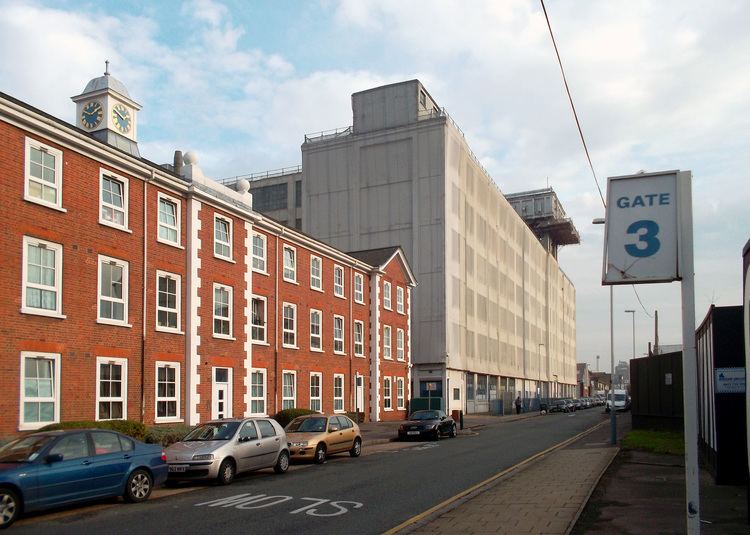Renovating firm U + I Group | Alternative names EMI Buildings Country United Kingdom Groundbreaking 9 February 1907 | |
 | ||
Renovation cost 250 million GBP (projected) Similar Hayes & Harlington, Webfusion, Stockley Park Grass Pitches, E M I Music Archives, West Drayton Station | ||
The Old Vinyl Factory is a complex of buildings formerly owned by the British music company EMI in Hayes, within the London Borough of Hillingdon. The site was originally purchased by the Gramophone and Typewriter Company and the buildings were designed by Wallis, Gilbert and Partners in the early 20th century.
Contents
While used by EMI, the site was responsible for the production of many well-known vinyl records by popular musicians of the 20th century, as well as radios and other broadcasting equipment.
In April 2011 the site was purchased for redevelopment by a joint venture of Cathedral Group PLC and Development Securities plc (now U + I Group). Under plans for £250 million of works, the site, covering 17 acres (6.9 ha), is to include commercial and residential units and a university technical college.
Nina nesbitt jessica the old vinyl factory sessions
History
The Gramophone and Typewriter Company, the precursor to EMI, purchased the site in the early 20th century and began constructing the first buildings in 1907. The company originally sold gramophones, and began making its own records in London in 1898 They were pressed at a factory in Germany until the Hayes Record Factory opened. From 1910, records bore the His Master's Voice label. The tenor Edward Lloyd took part in the groundbreaking ceremony. Vinyl records were produced from 1952.
What became the Cabinet Building was opened in 1911, after the Italian soprano Luisa Tetrazzini laid the cornerstone. The following year, a head office was built nearby on the site. During the First World War, the factory was used for the production of munitions.
During the period 1927-29 the site was further extended with alterations and additions designed by Wallis, Gilbert and Partners (January 1927-cabinet department extensions; November 1927-record store; 1927-28-research laboratories, the administration building extension and the power house; November 1928-evaporating plant extension; May 1929-shipping department). The site covered 58 acres (23 ha) by 1929 and 7,500 people were employed across it.
The factories again returned to the production of munitions during the Second World War, as well as domestic radio receivers, which were marketed with some adaptations to households by the Home Office for £12. The site was bombed on 7 July 1944, killing 37 employees.
In 1952, EMI began the production of "microgroove" records, made of vinyl rather than the shellac-based compound used for earlier records. Many major artists of the time - including The Beatles, The Rolling Stones, Cliff Richard and Pink Floyd - had their vinyl records produced at the site. Production reached its peak in the 1960s at the Hayes site, which covered 150 acres (61 ha) and saw 14,000 people in work there.
In the 1970s, EMI moved its record-pressing operations to a different site, still within Hayes and many of the buildings on the site moved over to defence electronics development and production.
Redevelopment
The site was purchased in April 2011 by Purplexed, a joint venture between Cathedral Group PLC and Development Securities plc. The purchasers renamed the site "The Old Vinyl Factory" (from "London Gate Business Park"). The buildings on the site were renamed according to their former functions - one example being the "Shipping Building", which was where records were stored before being dispatched elsewhere. Purplexed stated the redevelopment would cost around £250 million to complete and that the company would give £40,000 to the London Borough of Hillingdon to cover the costs involved with putting the plan together.
A seven-storey block of flats was announced as part of the development in February 2012. Its name, the Gatefold Building, was chosen as a wistful allusion to the gatefold sleeves of certain of EMI's vinyl record releases. Planning permission for the building was granted in February 2012.
The master plan for the entire site was approved by Hillingdon Council on 30 November 2012. It includes a new building, known as "The Picturehouse", which will house a Vue cinema. The site will also feature offices, 500 flats, a museum, restaurants, landscaped areas and playgrounds.
By February 2015, Sonos, Host Europe Group and CHAMP Cargosystems had signed agreements to occupy the Shipping Building.
The Global Academy secondary school opened in 2016 on the site originally planned as "The Picturehouse". The "Gatefold Building" is now also completed as of late 2016. As of March 2017 a new multi storey car park dubbed "The Music Box" is currently under construction at the west end of the site near Dawley Road/Bourne Bridge. Work is rapidly reaching completion at various points on site as of March 2017.
